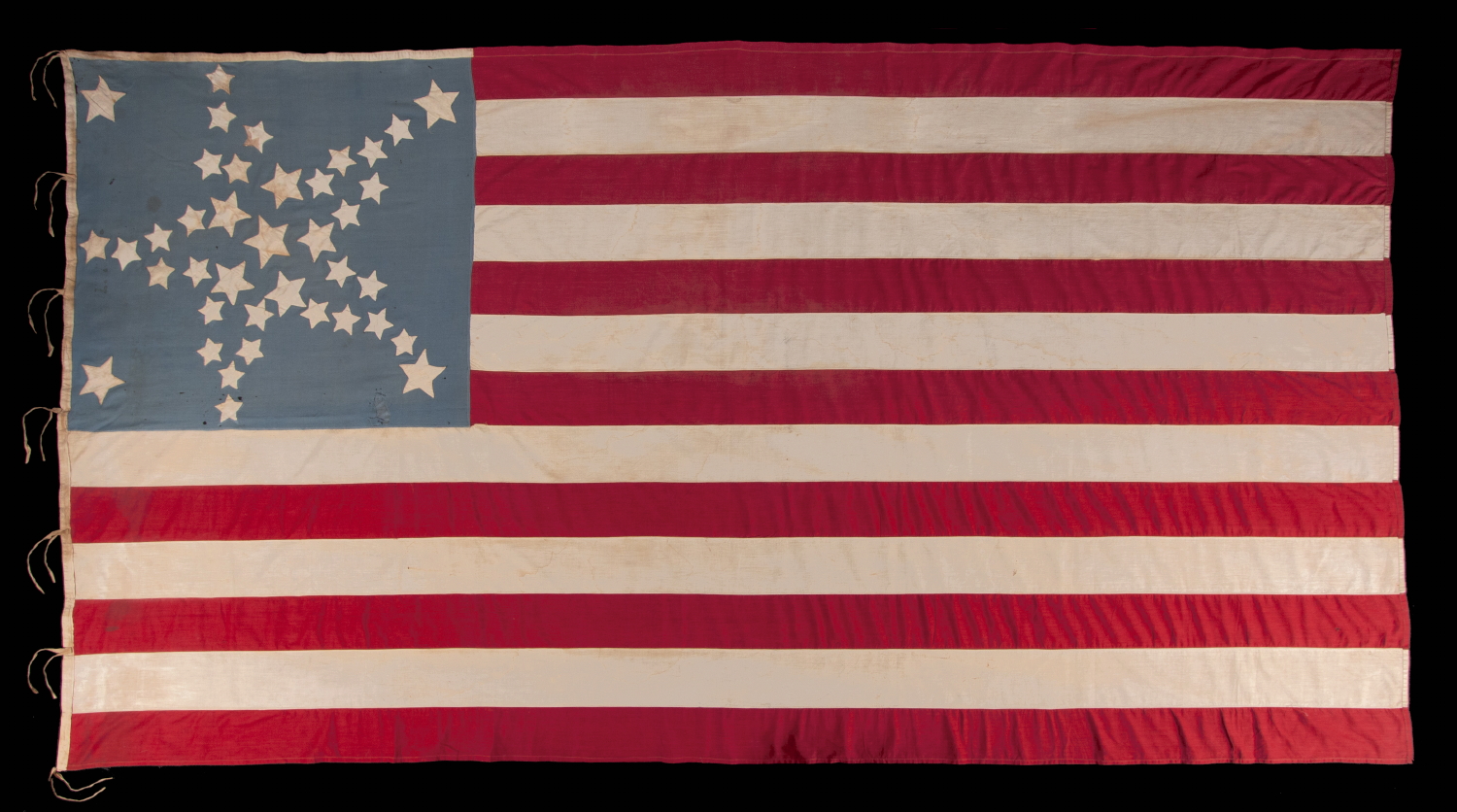


| 34 STARS IN A WHIMSICAL RENDITION OF THE GREAT STAR PATTERN, ON A CIVIL WAR PERIOD FLAG WITH A CORNFLOWER BLUE CANTON, MADE WHEN KANSAS WAS THE MOST RECENT STATE TO JOIN THE UNION; UPDATED TO 39 STARS, IN 1876, IN ANTICIPATION OF THE ADDITION OF THE DAKOTA TERRITORY AS ONE STATE |
|
| Web ID: | 34j-841 |
| Available: | In Stock |
| Frame Size (H x L): | |
| Flag Size (H x L): | 68" x 129" |
| Description: | |
| 34 star American national flag with additional stars added and one of the most stunning graphic designs I have ever seen in early flag-making. The original pattern was comprised of a circle of 5 large stars, and triangular arms made of smaller stars. These are noticeable pointy and bent like the arms of a starfish. Made of cotton, the stars are hand-sewn and double-appliquéd to a fantastic, cornflower blue canton, a color common to Civil War uniforms. The 34 state, Kansas, joined the Union in 1861, the opening year of the Civil War, and the 34 star flag was used until 1863. Five additional stars, even larger in size, were added, one in each corner and one in the very center. This probably occurred in 1876, for use at the celebration of our nation’s 100-year anniversary of independence. We received our 38th state in 1876, but 39 star flags were also being made at the time, in hopeful anticipation of the addition of another state. The 39th state did not come for another 13 years, which makes centennial-era 39 star flags both an oddity and a testament to American desire for continued growth. Two of the 5 additional stars extend the already exaggerated arms of the star, furthering its already whimsical qualities. The result is a folk art masterpiece in early American flag-making. The configuration’s basic design, a large star made out of smaller stars, has nearly countless variations. It is generally known as the "Great Star," but when it has an open center, like this flag once had before its center star was added, it has also been called the Great Flower. Among collectors, the Great Star configuration is the most coveted of all 19th century geometric patterns. Shortly after the War of 1812, American naval hero, Captain Samuel Reid, suggested to the president that the Great Star should be considered to become the first official star design. Reid’s primary concern was that, as more and more states joined the Union, our flag needed to be kept recognizable on the open seas. Naval use was the primary reason for the American ensign in the first place, and Reid’s proposal would have kept the star constellation in roughly the same form, and in an easily recognized design that could be quickly identified through a spyglass as the number of states grew. Sadly, Reid’s proposal was rejected due to the increased cost of arranging the stars in this manner. Never-the-less, since there was no official star pattern, the great star was produced by anyone willing to make it. Its rarity today, along with its beauty, has driven the desirability of American flags with this configuration. The stripes of the flag are made of cotton and sewn with a treadle machine. The canton is made of clothing grade wool. The original 34 stars are hand-sewn, while the added stars were appliquéd with a treadle machine. At the opening of the Civil War, the sewing machine was very new. Singer had mass-marketed it just 6 years prior. For this reason, people were not yet proficient in the skills needed to turn a piece of fabric, while folding under the edges of the fabric stars and pumping a treadle machine to appliqué them. By 1876, more persons had acquired this skill, though it was still more common for stars to be hand-sewn. A cotton hoist is applied with hand-stitching and finished by treadle machine. The top of the canton is bound in the same manner as the hoist, which is highly unusual. This was probably because this length of wool was cut on all sides and thus had no selvage to keep it from fraying. The wool would usually have been hemmed under in this case, but here the maker instead chose to apply a binding. Cotton ties are hand-sewn along the hoist so that the flag could be affixed to a staff. Kansas was admitted into the Union as the 34th state on January 29th, 1861, about 2 ½ months before the Confederate assault on Fort Sumter that marked the beginning of the Civil War. The 34th star was officially added on July 4th of that year, but most flag makers would have added a 34th star with the addition of Kansas in January. The star count remained official until July 4th, 1863, and 34 star flags would have been produced until the addition of West Virginia in June of that year. Mounting: The flag has not yet been mounted. |
|
| Video: | |
| Collector Level: | Flags for the truest Patriots. My best offerings |
| Flag Type: | Sewn flag |
| Star Count: | 34 |
| Earliest Date of Origin: | 1861 |
| Latest Date of Origin: | 1863 |
| State/Affiliation: | Kansas |
| War Association: | 1861-1865 Civil War |
| Price: | Please call (717) 676-0545 or (717) 502-1281 |
| E-mail: | info@jeffbridgman.com |
 |
|